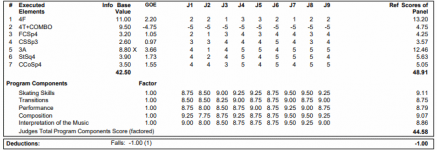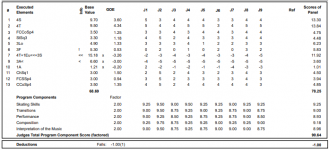In the run-up to the biggest figure skating event of the season, the 2019 World Championships, the International Skating Union (ISU) judge and technical controller Mona Adolfsen (President of the Norwegian Skating Association) tells about her motivation to work as an ISU judge as well as the peculiarities of the new ISU judging system.
More...
What's your take?
At the 2017 World Figure Skating Championships, held in Helsinki, Adolfsen (Judge No. 8) awarded Evgenia Medvedeva, the first Russian woman ever to successfully defend her world title, a perfect score of 10.00 in "Performance" as part of the component score. She was the only lady in the competition to receive 10.00s at the event.
Since then, some significant changes to the ISU judging system have been implemented. The biggest changes that are in effect from this season are to the way that elements are now evaluated. For example, the Grade of Execution (GOE) has been changed to a minus-5 to plus-5 range. In addition, a 10 percent bonus is added to the base value of a jump when performed after the halfway point of a program (for the last jump element in a short program and for three jump elements in free skating).
“Very often it takes some time before we get the changes completely 'under the skin,'” said Adolfsen. "With the changes going from +/- 3 to +/- 5, the differences in each individual element can be greater. It will be an advantage, especially when the figure skaters make several mistakes in a single element. At the same time, we see that the differences sometimes become greater between the scores awarded by the judges.”
With this new scale, differences in scores from judges can occur for various reasons.
“The explanation for such differences is that judges are not completely used to the new scale," Adolfsen pointed out. "There may be a different interpretation of the guidelines as well. One may press the wrong button when entering scores. Some judges may believe they have seen, for example, not a fully rotated jump or landing it on two feet, or other things. Sometimes one judge throughout the competition awards lower scores than all the other judges. At the same time, it must be said that if there was a requirement that everyone should award exactly the same score, then only one judge would be needed.”
The ISU regulations say that in a program containing Falls or Serious errors, the score nine-fifty (9.5) or higher should not be awarded for Skating Skills, Transitions and Composition and the score nine (9.0) or higher should not be awarded for Performance and Interpretation. However, sometimes we see that judges do not follow this rule and award such scores for components in programs with falls and serious errors as seen below.
(Click to Enlarge)
“I do not know what lies behind the scores for the components when they are as high as they are in the programs performed with falls and obvious errors,” admitted Adolfsen. “We have now clear guidelines, but they have only become clearer this season. It is good for the sport. I wouldn’t like to comment on the way the judges award high scores in such situations, as it will be wrong of me as a judge. We shall not comment on such things in accordance with our code of ethics as well, but what I can say is that there is no kind of exception to whom it applies.”
More...
What's your take?
Last edited:







